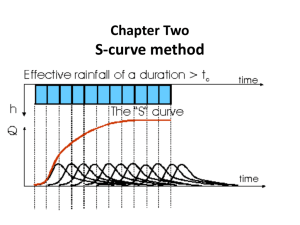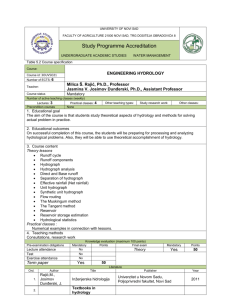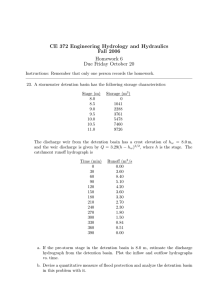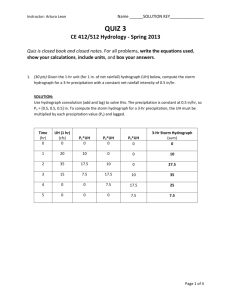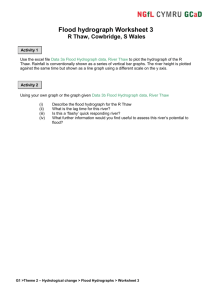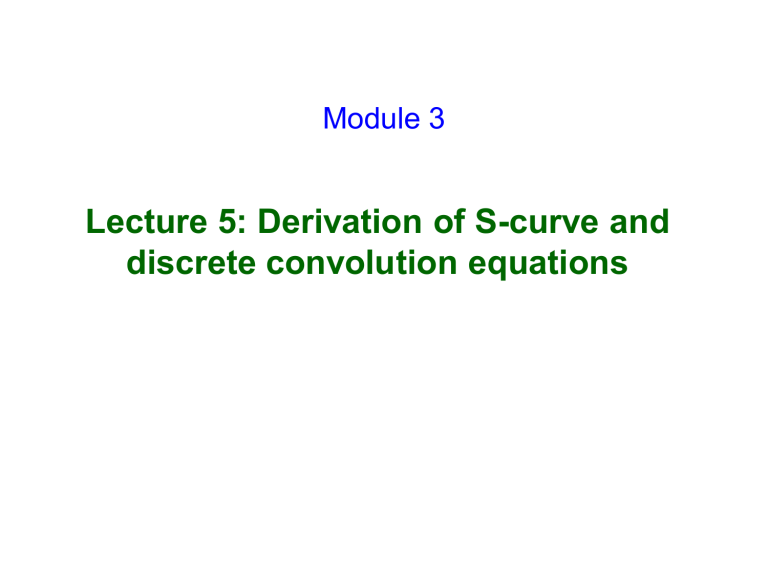
Module 3 Lecture 5: Derivation of S-curve and discrete convolution equations Unit hydrograph S – Curve method • It is the hydrograph of direct surface discharge that would result from a continuous succession of unit storms producing 1cm(in.)in tr –hr • If the time base of the unit hydrograph is Tb hr, it reaches constant outflow (Qe) at T hr, since 1 cm of net rain on the catchment is being supplied and removed every tr hour and only T/tr unit graphs are necessary to produce an S-curve and develop constant outflow given by, Qe = (2.78·A) / tr where Qe = constant outflow (cumec) tr = duration of the unit graph (hr) A = area of the basin (km2 or acres) Module 3 Unit hydrograph S – Curve method Contd… Intensity (cm/hr) Changing the duration of UG by S-curve technique Successive unit storms of Pnet = 1 cm To obtain tr-hr UG multiply the S-curve difference by tr/trI Discharge Q (Cumec) S-curve hydrograph Unit hydrograph in Succession produce Constant outflow Qe cumec Lagged s-curve Lagged by tr-hr trI Lagged Time t (hr) Constant flow Qe (Cumec) Module 3 Unit hydrograph Example Problem • Convert the following 2-hr UH to a 3-hr UH using the S-curve method Time (hr) 2-hr UH ordinate (cfs) 0 0 Solution 1 75 Make a spreadsheet with the 2-hr 2 250 UH ordinates, then copy them in 3 300 the next column lagged by D=2 4 275 hours. Keep adding columns until 5 200 6 7 100 75 8 50 9 25 10 0 the row sums are fairly constant. The sums are the ordinates of your S-curve Module 3 Unit hydrograph Example Problem Contd… Time (hr) 2-hr UH 0 0 0 1 75 75 2 250 0 250 3 300 75 375 4 275 250 0 525 5 200 300 75 575 6 100 275 250 0 625 7 75 200 300 75 650 8 50 100 275 250 0 675 9 25 75 200 300 75 675 10 0 50 100 275 250 0 675 25 75 200 300 75 675 11 2-HR lagged UH’s Sum Module 3 Unit hydrograph Example Problem Contd… Draw your S-curve, as shown in figure below 800 S-curve 700 600 Q (cfs) 500 2 hr UH Lagged by 2 hr 400 300 200 100 0 0 2 4 6 Time (hr) 8 10 12 14 Make a spreadsheet with the 2-hr UH ordinates, then copy them in the next column lagged by D=2 hours. Keep adding columns until the row sums are fairly constant. The sums are the ordinates of your S-curve. Module 3 Unit hydrograph Example Problem Time (hr) Contd… S-curve ordinate S-curve lagged 3hr Difference 3-HR UH ordinate 0 0 0 0 1 75 75 50 2 250 250 166.7 3 375 0 375 250 4 525 75 450 300 5 575 250 352 216 6 625 375 250 166.7 7 650 525 125 83.3 8 675 575 100 66.7 9 675 625 50 33.3 10 675 650 25 16.7 11 675 675 0 0 Unit hydrograph Example Problem Find the one hour unit hydrograph using the excess rainfall hyetograph and direct runoff hydrograph given in the table Time (1hr) Excess Rainfall (in) Direct Runoff (cfs) 1 1.06 428 2 1.93 1923 3 1.81 5297 4 9131 5 10625 6 7834 7 3921 8 1846 9 1402 10 830 11 313 Module 3 Contd…. Unit hydrograph Discrete Convolution Equation Suppose that there are M pulses of excess rainfall. If N pulses of direct runoff are considered, then N equations can be written Qn in terms of N-M+1unknown values of unit hydrograph ordinates, where n= 1, 2, …,N. m* Qn = ∑ PmUn−m+1 m=1 m* = min(n,M) Where Qn = Direct runoff Pm = Excess rainfall Un-m+1 = Unit hydrograph ordinates Contd…. Unit hydrograph Input Pn P1 P2 Output Qn m* Output Qn = ∑ PmUn−m+1 P3 m=1 Unit pulse response applied to P1 Un-m+1 Combination of 3 rainfall UH U1 U2 U3 U4 U5 n-m+1 Un-m+1 Unit pulse response applied to P2 n-m+1 Unit hydrograph Contd…. The set of equations for discrete time convolution Q1 = PU 11 = Q 2 P2U1 + PU 1 2 Q3 =P3U1 + P2U2 + PU 1 3 QM = PMU1 + PM−1U2 + ..... + PU 1 M QM+1 = 0 + PMU2 + ..... + P2UM + PU 1 M+1 QN−1 = 0 + 0 + ..... + 0 + 0 + ..... + PMUN−M + PM−1UN−M+1 QN = 0 + 0 + ..... + 0 + 0 + ..... + 0 + PM−1UN−M+1 m* Qn = ∑ PmUn−m+1 m=1 n = 1, 2,…,N Unit hydrograph Example Problem Contd… Solution • The ERH and DRH in table have M=3 and N=11 pulses respectively. • Hence, the number of pulses in the unit hydrograph is N-M+1=11-3+1=9. • Substituting the ordinates of the ERH and DRH into the equations in table yields a set of 11 simultaneous equations = U1 Q2 − P2U1 1,928 − 1.93x404 = = 1,079 cfs / in P1 1.06 Similarly calculate for remaining ordinates and the final UH is tabulated below n Un (cfs/in) 1 2 3 4 5 6 7 8 9 404 1,079 2,343 2,506 1,460 453 381 274 173 Module 3
